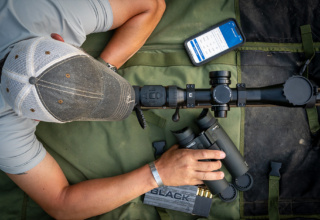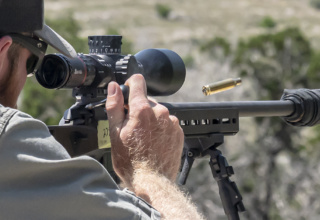When the hunt requires burning boot leather and making “way out there” shots, preparation and good equipment are key ingredients.
by Heath Wood
As last year’s youth deer hunt was getting underway in my home state of Missouri, I was planning a hunt with a family who has been friends of ours for several years, hoping to continue our streak of fun, exciting, and successful youth hunts with their oldest son, Avery.
In the past, Avery and I had turkey hunted together, which led to Avery’s first gobbler a couple of springs prior. This year, however, would be our first time to deer hunt. Our hunt would be part of the mid-October, two-day-only season that Missouri has for kids 15 years of age and younger. As I talked with Avery’s parents about our hunt, they informed me that he had become an accomplished shooter. Avery had been practicing shooting his rifle at several different distances for weeks prior to the youth season, which gave me a boost of confidence on his shooting ability, if faced with a longer shot opportunity. Even knowing how much he had practiced, what was about to take place was beyond my wildest expectations.
On the first morning of the two-day youth hunt, Avery and I assembled a pop-up-style ground blind along the side of a steep hill overlooking a massive river bottom that had been turned into a cow pasture. We were able to get the blind in place and ourselves in position several minutes before first light. As the morning progressed, the first deer made its way down a hill a mere 20 yards away. I quickly whispered that a small buck was heading our way and asked if he wanted to attempt a shot. Avery whispered back that he wanted to wait for a little bigger buck.
I’m glad he did, because as the morning stretched on, several does spread out across the bottom field. Watching the does feed around the pasture, I caught sight of a nice 8-pointer making his way over the horizon about 500 yards distance. For the next hour, we watched the 8-pointer and a smaller 6-point buck chase does around the pasture. Finally, three of the does started toward us with the 8-point following right behind them.
Although they hung up at 250 yards, Avery assured me that he was steady and that he could make the shot. I’m ashamed to admit I didn’t have much faith that he could pull it off at that range. Once he convinced me to let him take the shot, I considered the ballistics of his setup and told him to aim two to three inches high. Avery slowly squeezed the trigger of his youth model rifle. I saw the buck flinch and then trot over the hill and out of sight.
As we sat in the blind for the next ten minutes, the emotions ran high for both of us. Avery was understandably excited, and I was anxious to know if he had made a successful shot. We eventually left the blind and trekked across the rolling pasture to the point we last saw the buck. Upon topping the last rise, we saw Avery’s buck lying few yards over the crest of the hill. I turned back to the blind and ranged the distance. The young man had made a perfect 261-yard shot on a nice Missouri 8-pointer. Avery’s parents were correct—their son had practiced enough to be make an impressive long-range shot.
As with Avery’s hunt, there are times when terrain and circumstances require one to make longer-than-normal shots, whether in a Midwest crop field, hunting mule deer on the Kansas flats, while elk hunting in the Rocky Mountains, or even when hunting a powerline right-of-way anywhere in the country.
Here are three things to help prepare you for those “out there” shot opportunities.
Be Comfortable and Have a Steady Rest
Being a good long-range shooter is, of course, important. Most people will go to the range to practice shooting on a shooting bench or some other type of steady rest. To be a successful long-range hunter, though, you must be able to use the terrain to your advantage and shoot accurately in the conditions you are given. This may require hiking down a canyon or taking a long detour along a field edge.
Once in position, you need to establish a steady rest. For hunting conditions that require lots of walking away from the truck or camp, I take my ALPS OutdoorZ Pursuit daypack. I can carry everything I need to support me for a half-day or full-day hunt, and it provides an ideal field rest when conditions allow me to shoot from the prone position.
Another beneficial item for shooting at distances of 200 yards or more is a bipod. I like Swagger Bipods’ Stalker QD42 model. This bipod is a lightweight, quick-detach bipod that is easy to carry. The QD42 has Swaggers’ flexible leg technology that easily adjusts to any terrain. Inside my daypack, I carry Swaggers’ Stalker Lite shooting sticks for those spot-and-stalk situations when shot opportunities will be 150 yards or closer. The Stalker Lite has a rapid-deploy design that allows for a quick transition from my daypack to a shooting position in a matter of seconds. These also flex with the landscape, providing a solid shooting rest on any terrain.
Use Good Optics
Quality optics, such as binoculars and a range finder, are important. I prefer using Nikon’s Black RangeX 4K Laser rangefinder, which is designed to range long distances and to range accurately on inclines and declines.
My next optic preference is the Nikon Monarch 5 10X42 binoculars. A good pair of binoculars not only helps to find an animal in the distance, but also to verify the animal’s size and quality. Often, I have spotted a whitetail buck and thought he was a shooter, but that assessment sometimes changes after observing him through binoculars.
Hunt with a Partner
There are many benefits to having a partner while hunting open country. When trying to spot an animal from a distance, another set of eyes helps. An observer can also help in determining shot placement and they can work the rangefinder, calling distances while you concentrate on shot execution.
A hunting partner is also great for spot-and-stalk situations. Having a friend observe from a high vantage point can help you close on the animal. I have had hunting partners give hand signals, indicating when it was safe to move, which direction to go, and when to try to make the shot.
A hunting partner also serves as a “pack mule” should the hunt be successful. When you’re miles from the truck, having someone to help carry hunting equipment and meat can be a life saver.
A successful hunt does not always conclude with an up-close-and-personal encounter with an animal. As with Avery’s hunt, practice makes perfect, yet there are other key factors that play into success. Sometimes, the challenge of battling the terrain and the obstacles faced along the way adds to the enjoyment. By taking advantage of key gear as well as a trusted hunting partner, a long-distance hunt is sure to result in fun and, quite possibly, a successful harvest.





















